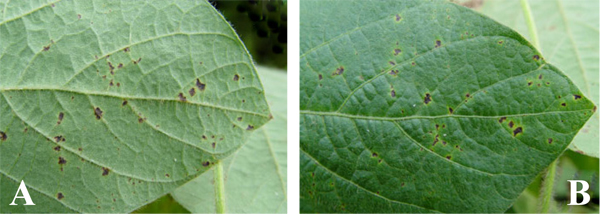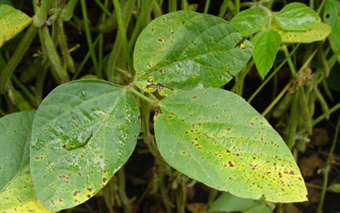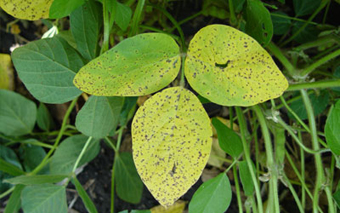G2059
Brown Spot of Soybean
Brown spot disease of soybean may affect crop development in Nebraska, but rarely decreases yields significantly. Learn how to implement cultural practices to manage it.
Loren J. Giesler, Extension Plant Pathologist
|
Brown spot is caused by the fungus Septoria glycines and may be called Septoria leaf spot. It was first reported in the United States in 1923 in North Carolina soybeans and is now widely distributed through the north central states, the mid Atlantic states, and the southeastern United States. In addition, it also occurs in many other temperate soybean growing regions of the world.
Brown spot (Figure 1) rarely affects soybean yield in Nebraska. In some years, it may hasten maturity by causing premature defoliation. Yield loss estimates due to brown spot range from 8 percent to 15 percent nationally and occur when 25-50 percent of the canopy prematurely defoliates. Severe brown spot infection usually results in smaller seed size. The disease is most severe when soybean is grown continuously in the same field, particularly in reduced tillage fields, since this is a residue-borne disease.
Symptoms
This disease is easily confused with soybean rust. Proper diagnosis is critical and should be confirmed by a diagnostic laboratory if there is any doubt. Brown spot lesions are irregularly shaped, light-brown spots found primarily on leaves, but also on stems, petioles, and pods. Brown spot lesions will not have a pustule (raised center) or spores that are visible (on leaf underside) with a 20X hand lens as is characteristic of soybean rust. Infection generally begins on the cotyledons and unifoliate leaves (lowest true leaves) when the weather is warm and wet. The disease progresses up the plant and the trifoliolate leaves soon develop symptoms with lesions, initially appearing as irregular light brown spots and later turning a blackish-brown color (Figure 2). At this stage, lesions are small but vary in size from minute specks to 1/8 inch (4 mm) in diameter. As the infection progresses, leaves become yellow and drop off the plant (Figure 3). Often lesions will enlarge and merge to form blotches. Infected leaves turn rusty brown and drop from the plant as the season progresses.
 |
| Figure 2. Lesions of brown spot on the (A) leaf underside and (B) corresponding upper surface of the leaf. |
|
Brown spot also can infect the petioles, seeds, pods, and stems of soybean. The pods and stems of infected plants will be marked by irregular brown lesions with indefinite borders. The lesions vary greatly in size. No visible symptoms of infection are observed on seed.
Disease Development
The primary source of the brown spot fungus in the spring is infected leaf and stem debris from the previous soybean crop. Spores or conidia are carried from the soil surface or debris to the plant by wind or splashing rain. Infection and disease development are favored by warm, moist weather, which promotes spore production in the primary lesions. Secondary spores produced on lesions in the cotyledons are blown to adjacent trifoliate leaves and under favorable conditions will initiate new infections. Temperatures of 59-86°F and high relative humidity are optimal for brown spot disease development. A leaf wetness period of six or more hours is required for the fungus to enter the stomata and infect the plant.
No other plant species has been found to be susceptible to the brown spot fungus under field conditions.
Management
While brown spot does not usually affect soybean yield in Nebraska, it does become progressively more severe when soybean is grown continuously in the same field. Management may require various tactics to reduce disease severity and yield loss. These include:
Crop rotation. If infection becomes progressively severe, rotate out of soybeans for at least one year.
Tillage. Soybean debris in fields with high levels of brown spot infection should be incorporated into the soil with tillage to increase the rate of decay of these plant tissues.
Resistance. Complete resistance of soybeans to brown spot has not been found; however, varieties will respond differently as tolerance to this disease varies.
Fungicide. Fungicides applied to soybeans between bloom and pod fill can reduce brown spot severity and increase yield in fields where this disease is a significant problem. The R3 (pod set) growth stage provides good timing for management.
Acknowledgment
The author would like to acknowledge the work of Tom J. Weissling, former post doctoral research associate, who contributed to the original edition of this publication.
This publication has been peer reviewed.
Visit the University of Nebraska–Lincoln Extension Publications Web site for more publications.
Index: Plant Diseases
Soybean
Issued May 2011

